Manipulating Reaction Energy Coordinate Landscape of Mechanochemical Diaza-Cope Rearrangement
Abstract
:1. Introduction
2. Results and Discussion
2.1. Solid Additive Effect in DCR Reaction between 1 and 2a
2.1.1. Screening of Different Common Laboratory Solid Additives for DCR Reaction
2.1.2. Screening of Silica Gel Loading for DCR Reaction
2.1.3. Comparison of Different Reaction Methods for DCR Reaction
2.1.4. Investigation of the Role of Silica Gel in DCR Reaction
2.2. Scope Comparison for Ball-Milling-Induced DCR Reactions with and without Silica Gel Additive
2.3. Mechanistic Studies of Silica Gel Catalyzed Mechanochemical DCR Reaction
2.3.1. Tracking the Reaction Profile in DCR Reaction with Silica Gel Additive by 1H NMR Spectroscopy
2.3.2. Mechanistic Proposal of Mechanochemical DCR Catalyzed by Silica Gel Additive
2.4. The Effect of Liquid Additives in DCR Reaction by Liquid-Assisted Grinding (LAG)
3. Materials and Methods
3.1. General Information
3.2. General Procedure for Mechanochemical Diaza-Cope Rearrangement (0.04 mmol Scale)
3.3. General Procedure for Mechanochemical Diaza-Cope Rearrangement (0.2 mmol Scale)
3.4. Characterization Data for Products
4. Conclusions
Supplementary Materials
Author Contributions
Funding
Institutional Review Board Statement
Informed Consent Statement
Data Availability Statement
Acknowledgments
Conflicts of Interest
References
- Tanaka, K.; Toda, F. Solvent-Free Organic Synthesis. Chem. Rev. 2000, 100, 1025–1074. [Google Scholar] [CrossRef] [PubMed]
- Ardila-Fierro, K.J.; Hernández, J.G. Sustainability Assessment of Mechanochemistry by Using the Twelve Principles of Green Chemistry. ChemSusChem 2021, 14, 2145–2162. [Google Scholar] [CrossRef] [PubMed]
- Colacino, E.; Isoni, V.; Crawford, D.; García, F. Upscaling Mechanochemistry: Challenges and Opportunities for Sustainable Industry. Trends Chem. 2021, 3, 335–339. [Google Scholar] [CrossRef]
- Pérez-Venegas, M.; Juaristi, E. Mechanochemical and Mechanoenzymatic Synthesis of Pharmacologically Active Compounds: A Green Perspective. ACS Sustain. Chem. Eng. 2020, 8, 8881–8893. [Google Scholar] [CrossRef]
- Avila-Ortiz, C.G.; Pérez-Venegas, M.; Vargas Caporali, J.; Juaristi, E. Recent Applications of Mechanochemistry in Enantioselective Synthesis. Tetrahedron Lett. 2019, 60, 1749–1757. [Google Scholar] [CrossRef]
- Pérez-Venegas, M.; Villanueva-Hernández, M.N.; Peña-Cabrera, E.; Juaristi, E. Mechanochemically Activated Liebeskind-Srogl (L-S) Cross-Coupling Reaction: Green Synthesis of meso-Substituted BODIPYs. Organometallics 2020, 39, 2561–2564. [Google Scholar] [CrossRef]
- Singh, V.K.; Chamberlain-Clay, A.; Ong, C.O.; León, F.; Hum, G.; Par, M.Y.; Daley-Dee, P.; García, F. Multigram Mechanochemical Synthesis of a Salophen Complex: A Comparative Analysis. ACS Sustain. Chem. Eng. 2021, 9, 1152–1160. [Google Scholar] [CrossRef]
- Belenguer, A.M.; Friščić, T.; Day, G.M.; Sanders, J.M.K. Solid-State Dynamic Combinatorial Chemistry: Reversibility and Thermodynamic Product Selection in Covalent Mechanosynthesis. Chem. Sci. 2011, 2, 696–700. [Google Scholar] [CrossRef]
- Shi, Y.X.; Xu, K.; Clegg, J.K.; Ganguly, R.; Hirao, H.; Friščić, T. The First Synthesis of the Sterically Encumbered Adamantoid Phosphazane P4(NtBu)6: Enabled by Mechanochemistry. Angew. Chem. Int. Ed. 2016, 55, 12736–12740. [Google Scholar] [CrossRef]
- Rightmire, N.R.; Hanusa, T.P.; Rheingold, A.L. Mechanochemical Synthesis of [1,3-(SiMe3)2C3H3]3(Al,Sc), a Base-Free Tris(allyl)aluminum Complex and Its Scandium Analogue. Organometallics 2014, 33, 5952–5955. [Google Scholar] [CrossRef] [Green Version]
- Haley, R.A.; Zeller, A.R.; Krause, J.A.; Guan, H.; Mack, J. Nickel Catalysis in a High Speed Ball Mill: A Recyclable Mechanochemical Method for Producing Substituted Cyclooctatetraene Compounds. ACS Sustain. Chem. Eng. 2016, 4, 2464–2469. [Google Scholar] [CrossRef]
- Komatsu, K.; Wang, G.W.; Murata, Y.; Tanaka, T.; Fujikawa, K.; Yamamoto, K.; Saunders, M. Mechanochemical Synthesis and Characterization of the Fullerene Dimer C120. J. Org. Chem. 1998, 63, 9358–9366. [Google Scholar] [CrossRef]
- Su, Y.-T.; Wang, G.-W. FeCl3-Mediated Cyclization of [60]Fullerene with N-Benzhydryl Sulfonamides under High-Speed Vibration Milling Conditions. Org. Lett. 2013, 15, 3408–3411. [Google Scholar] [CrossRef] [PubMed]
- Jia, K.-Y.; Yu, J.-B.; Jiang, Z.-J.; Su, W.-K. Mechanochemically Activated Oxidative Coupling of Indoles with Acrylates through C–H Activation: Synthesis of 3-Vinylindoles and β,β-Diindolyl Propionates and Study of the Mechanism. J. Org. Chem. 2016, 81, 6049–6055. [Google Scholar] [CrossRef] [PubMed]
- Zhao, Y.; Rocha, S.V.; Swager, T.M. Mechanochemical Synthesis of Extended Iptycenes. J. Am. Chem. Soc. 2016, 138, 13834–13837. [Google Scholar] [CrossRef] [PubMed]
- Hernández, J.; Macdonald, N.A.; Mottillo, C.; Butler, I.S.; Friščić, T. A Mechanochemical Strategy for Oxidative Addition: Remarkable Yields and Stereoselectivity in the Halogenation of Organometallic Re(I) Complexes. Green. Chem. 2014, 16, 1087–1092. [Google Scholar] [CrossRef]
- Strukil, V.; Bracin, D.; Magdysyuk, O.V.; Dinnebier, R.E.; Friščić, T. Trapping Reactive Intermediates by Mechanochemistry: Elusive Aryl N-Thiocarbamoylbenzotriazoles as Bench-Stable Reagents. Angew. Chem. Int. Ed. 2015, 54, 8440–8443. [Google Scholar] [CrossRef] [Green Version]
- Wang, G.-W.; Komatsu, K.; Murata, Y.; Shiro, M. Synthesis and X-ray Structure of Dumb-Bell-Shaped C120. Nature 1997, 387, 583–586. [Google Scholar] [CrossRef]
- Howard, J.L.; Brand, M.C.; Browne, D.L. Switching Chemoselectivity: Using Mechanochemistry to Alter Reaction Kinetics. Angew. Chem. Int. Ed. 2018, 57, 16104–16108. [Google Scholar] [CrossRef]
- Seo, T.; Kubota, K.; Ito, H. Selective Mechanochemical Monoarylation of Unbiased Dibromoarenes by in Situ Crystallization. J. Am. Chem. Soc. 2020, 142, 9884–9889. [Google Scholar] [CrossRef]
- Kaabel, S.; Stein, R.S.; Fomitšenko, M.; Jarving, I.; Friščić, T.; Aav, R. Size-Control by Anion Templating in Mechanochemical Synthesis of Hemicucurbiturils in the Solid State. Angew. Chem. Int. Ed. 2019, 58, 6230–6234. [Google Scholar] [CrossRef] [PubMed]
- Tan, D.; Mottillo, C.; Katsenis, A.D.; Strukil, V.; Friščić, T. Development of C-N Coupling Using Mechanochemistry: Catalytic Coupling of Arylsulfonamides and Carbodiimides. Angew. Chem. Int. Ed. 2014, 53, 9321–9324. [Google Scholar] [CrossRef] [PubMed]
- Koby, R.F.; Hanusa, T.P.; Schley, N.D. Mechanochemically Driven Transformations in Organotin Chemistry: Stereochemical Rearrangement, Redox Behavior, and Dispersion-Stabilized Complexes. J. Am. Chem. Soc. 2018, 140, 15934–15942. [Google Scholar] [CrossRef] [PubMed]
- Liu, Y.; Liu, F.; Yan, K. Mechanochemical Access to a Short-Lived Molecular Rectangle Pd2L2: An Elusive Kinetic Species to Molecular Triangle Pd3L3 and Molecular Square Pd4L4. Angew. Chem. Int. Ed. 2022, 61, e202116980. [Google Scholar] [CrossRef] [PubMed]
- Lucet, D.; Le Gall, T.; Mioskowski, C. The Chemistry of Vicinal Diamines. Angew. Chem. Int. Ed. 1998, 37, 2580–2627. [Google Scholar] [CrossRef]
- Lee, J.H.; Jeong, A.R.; Shin, I.-S.; Kim, H.-J.; Hong, J.-I. Fluorescence Turn-On Sensor for Cyanide Based on a Cobalt(II)-Coumarinylsalen Complex. Org. Lett. 2010, 12, 764–767. [Google Scholar] [CrossRef] [PubMed]
- Akine, S.; Hotate, S.; Nabeshima, T. A Molecular Leverage for Helicity Control and Helix Inversion. J. Am. Chem. Soc. 2011, 133, 13868–13871. [Google Scholar] [CrossRef]
- Portner, K.; Nieger, M.; Vögtle, F. Dendritic EDA-Schiff Bases of the Salen-Type. Synlett 2004, 1167–1170. [Google Scholar]
- Szmuszkovicz, J.; Von Voigtlander, P.F.; Kane, M.P. A New Nontricyclic Antidepressant Agent. Synthesis and Activity of N-[trans-2-dimethylaminocyclopentyl]-N-(3,4-dichlorophenyl)propanamide and Related Compounds. J. Med. Chem. 1981, 24, 1230–1236. [Google Scholar] [CrossRef]
- Otsuka, M.; Masuda, T.; Haupt, T.; Ohno, M.; Shiraki, T.; Sugiura, Y.; Maeda, K. Man-Designed Bleomycin with Altered Sequence Specificity in DNA Cleavage. J. Am. Chem. Soc. 1990, 112, 838–845. [Google Scholar] [CrossRef]
- Vassilev, L.T.; Vu, B.T.; Graves, B.; Carvajal, D.; Podlaski, F.; Filipovic, Z.; Kong, N.; Kammlott, U.; Lukacs, C.; Klein, C.; et al. In Vivo Activation of the p53 Pathway by Small-Molecule Antagonists of MDM2. Science 2004, 303, 844–848. [Google Scholar] [CrossRef] [PubMed] [Green Version]
- Kim, M.; Kim, H.; Kim, H.; Chin, J. Synthesis of Enantiopure Mixed Alkyl-Aryl Vicinal Diamines by the Diaza-Cope Rearrangement: A Synthesis of (+)-CP-99,994. J. Org. Chem. 2017, 82, 12050–12058. [Google Scholar] [CrossRef] [PubMed]
- Gust, R.; Burgemeister, T.; Mannschreck, A.; Schönenberger, H. Aqua[1-(2,6-dichloro-4-hydroxyphenyl)-2-phenylethylenediamine](sulfato)platinum(II) Complexes with Variable Substituents in the 2-Phenyl Ring. 1. Synthesis and Antitumor and Estrogenic Properties. J. Med. Chem. 1990, 33, 2535–2544. [Google Scholar] [CrossRef] [PubMed]
- Reedijk, J. Improved Understanding in Platinium Antitumour Chemistry. Chem. Commun. 1996, 801–806. [Google Scholar] [CrossRef]
- Hettinger, T.P.; Craig, L.C. Edeine. IV. Structures of the Antibiotic Peptides Edeines A1 and B1. Biochemistry 1970, 9, 1224–1232. [Google Scholar]
- Marquet, A. Biotin Biosynthesis. Pure Appl. Chem. 1993, 65, 1249–1252. [Google Scholar] [CrossRef]
- Kotti, S.R.S.; Timmons, C.; Li, G. Vicinal Diamino Functionalities as Privileged Structural Elements in Biologically Active Compounds and Exploitation of their Synthetic Chemistry. Chem. Biol. Drug Des. 2006, 67, 101–114. [Google Scholar] [CrossRef]
- Zhang, W.; Loebach, J.L.; Wilson, S.R.; Jacobsen, E.N. Enantioselective Epoxidation of Unfunctionalized Olefins Catalyzed by Salen Manganese Complexes. J. Am. Chem. Soc. 1990, 112, 2801–2803. [Google Scholar] [CrossRef]
- Wang, X.; Reisinger, C.M.; List, B. Catalytic Asymmetric Epoxidation of Cyclic Enones. J. Am. Chem. Soc. 2008, 130, 6070–6071. [Google Scholar] [CrossRef]
- Jacobsen, E.N. Asymmetric Catalysis of Epoxide Ring-Opening Reactions. Acc. Chem. Res. 2000, 33, 421–431. [Google Scholar] [CrossRef]
- Noyori, R.; Ohkuma, T. Asymmetric Catalysis by Architectural and Functional Molecular Engineering: Practical Chemo- and Stereoselective Hydrogenation of Ketones. Angew. Chem. Int. Ed. 2001, 40, 40–73. [Google Scholar] [CrossRef]
- Machacek, M.R.; Aponick, A.; Trost, B.M. Predicting the Stereochemistry of Diphenylphosphino Benzoic Acid (DPPBA)-Based Palladium-Catalyzed Asymmetric Allylic Alkylation Reactions: A Working Model. Acc. Chem. Res. 2006, 39, 747–760. [Google Scholar]
- Doyle, A.G.; Jacobsen, E.N. Small-Molecule H-Bond Donors in Asymmetric Catalysis. Chem. Rev. 2007, 107, 5713–5743. [Google Scholar] [CrossRef] [PubMed]
- Nishioka, Y.; Yamaguchi, T.; Kawano, M.; Fujita, M. Asymmetric [2 + 2] Olefin Cross Photoaddition in a Self-Assembled Host with Remote Chiral Auxiliaries. J. Am. Chem. Soc. 2008, 130, 8160–8161. [Google Scholar] [CrossRef] [PubMed]
- Hatakeyama, Y.; Sawada, T.; Kawano, M.; Fujita, M. Conformational Preferences of Short Peptide Fragments. Angew. Chem. Int. Ed. 2009, 48, 8695–8698. [Google Scholar] [CrossRef]
- Tozawa, T.; Jones, J.T.; Swamy, S.I.; Jiang, S.; Adams, D.J.; Shakespeare, S.; Clowes, R.; Bradshaw, D.; Hasell, T.; Chong, S.Y.; et al. Porous Organic Cages. Nat. Mater. 2009, 8, 973–978. [Google Scholar] [CrossRef]
- Bojdys, M.J.; Briggs, M.E.; Jones, J.T.A.; Adams, D.J.; Chong, S.Y.; Schmidtmann, M.; Cooper, A.I. Supramolecular Engineering of Intrinsic and Extrinsic Porosity in Covalent Organic Cages. J. Am. Chem. Soc. 2011, 133, 16566–16571. [Google Scholar] [CrossRef]
- Liu, M.; Zhang, L.; Little, M.A.; Kapil, V.; Ceriotti, M.; Yang, S.; Ding, L.; Holden, D.L.; Balderas-Xicohténcatl, R.; He, D.; et al. Barely Porous Organic Cages for Hydrogen Isotope Separation. Science 2019, 366, 613–620. [Google Scholar] [CrossRef]
- Giri, N.; Del Pópolo, M.G.; Melaugh, G.; Greenaway, R.L.; Rätzke, K.; Koschine, T.; Pison, L.; Costa Gomes, M.F.; Cooper, A.I.; James, S.L. Liquid with Permanent Porosity. Nature 2015, 527, 216–219. [Google Scholar] [CrossRef]
- Wang, X.; Wang, Y.; Yang, H.; Fang, H.; Chen, R.; Sun, Y.; Zheng, N.; Tan, K.; Lu, X.; Tian, Z.; et al. Assembled Molecular Face-Rotating Polyhedra to Transfer Chirality from Two to Three Dimensions. Nat. Commun. 2016, 7, 12469. [Google Scholar] [CrossRef] [Green Version]
- Wang, Y.; Fang, H.; Tranca, I.; Qu, H.; Wang, X.; Markvoort, A.J.; Tian, Z.; Cao, X. Elucidation of the Origin of Chiral Amplification in Discrete Molecular Polyhedra. Nat. Commun. 2018, 9, 488. [Google Scholar] [CrossRef] [PubMed] [Green Version]
- Chong, A.O.; Oshima, K.; Sharpless, K.B. Synthesis of Dioxobis(tert-alkylimido)osmium(VIII) and Oxotris(tert-alkylimido)osmium(VIII) Complexes. Stereospecific Vicinal Diamination of Olefins. J. Am. Chem. Soc. 1977, 99, 3420–3426. [Google Scholar] [CrossRef]
- Becker, P.N.; White, M.A.; Bergman, R.G. A New Method for 1,2-Diamination of Alkenes Using Cyclopentadienylnitrosylcobalt Dimer/NO/LiAlH4. J. Am. Chem. Soc. 1980, 102, 5676–5677. [Google Scholar] [CrossRef]
- Du, H.; Yuan, W.; Zhao, B.; Shi, Y. Catalytic Asymmetric Diamination of Conjugated Dienes and Triene. J. Am. Chem. Soc. 2007, 129, 11688–11689. [Google Scholar] [CrossRef] [PubMed]
- Fu, N.; Sauer, G.S.; Saha, A.; Loo, A.; Lin, S. Metal-Catalyzed Electrochemical Diazidation of Alkenes. Science 2017, 357, 575–579. [Google Scholar] [CrossRef] [PubMed] [Green Version]
- Tao, Z.; Gilbert, B.B.; Denmark, S.E. Catalytic, Enantioselective syn-Diamination of Alkenes. J. Am. Chem. Soc. 2019, 141, 19161–19170. [Google Scholar] [CrossRef]
- Wu, M.; Fan, T.; Chen, S.; Han, Z.; Gong, L. Pd(II)-Catalyzed Asymmetric Oxidative 1,2-Diamination of Conjugated Dienes with Ureas. Org. Lett. 2018, 20, 2485–2489. [Google Scholar] [CrossRef]
- Roland, S.; Mangeney, P.; Alexakis, A. A Practical and Efficient Synthesis of Enantiomerically Pure Di-tert-butyl-ethanediamine. Synthesis 1999, 228–230. [Google Scholar] [CrossRef]
- Alvaro, G.; Grepioni, F.; Grilli, G.; Maini, L.; Martelli, D.; Savoia, D. Asymmetric Synthesis of 1,2-Diamines by the Addition of Allylic Zinc and Magnesium Reagents to N,N′-Bis[(S)-1-phenylethyl)]ethanediimine. Synthesis 2000, 4, 581–587. [Google Scholar] [CrossRef]
- Anaya de Parrodi, C.; Juaristi, E. Chiral 1,2-Aminoalcohols and 1,2-Diamines Derived from Cyclohexene Oxide. Recent Applications in Asymmetric Synthesis. Synlett 2006, 2699–2715. [Google Scholar] [CrossRef]
- Vemula, R.; Wilde, N.C.; Goreti, R.; Corey, E.J. A New, Short, and Stereocontrolled Synthesis of C2-Symmetric 1,2-Diamines. Org. Lett. 2017, 19, 3883–3886. [Google Scholar] [CrossRef] [PubMed]
- Lee, D.A.; Bender, D.M.; Roohi, A.H.; Nantz, M.H. An Enantioselective Synthesis of Vicinal Diamines. J. Org. Chem. 1992, 57, 6653–6657. [Google Scholar]
- Roskamp, E.J.; Pedersen, S.F. Convenient Routes to Vicinal Diamines. Coupling of Nitriles or N-(trimethylsilyl) Imines Promoted by NbCl4(THF)2. J. Am. Chem. Soc. 1987, 109, 3152–3154. [Google Scholar] [CrossRef]
- Taniguchi, N.; Uemura, M. Stereoselective Pinacol Coupling of Planar Chiral (Benzaldehyde)Cr(CO)3, (Benzaldimine)Cr(CO)3, Ferrocenecarboxaldehyde and (Dienal)Fe(CO)3 Complexes with Samarium Diiodide. Tetrahedron 1998, 54, 12775–12788. [Google Scholar] [CrossRef]
- Xu, M.; Zhong, Y.; Sun, X.; Lin, G. An Advance on Exploring N-tert-Butanesulfinyl Imines in Asymmetric Synthesis of Chiral Amines. Acc. Chem. Res. 2008, 41, 831–840. [Google Scholar]
- Kitajima, K.; Nagatomo, R.; Fujimoto, T. Diastereoselective Imino-Pinacol Coupling of Chiral Imines Promoted by Mg(0) and a Grignard Reagent. Tetrahedron 2015, 71, 977–981. [Google Scholar] [CrossRef] [Green Version]
- Kim, H.; Nguyen, Y.; Yen, C.P.-H.; Chagal, L.; Lough, A.J.; Kim, B.M.; Chin, J. Stereospecific Synthesis of C2 Symmetric Diamines from the Mother Diamine by Resonance-Assisted Hydrogen-Bond Directed Diaza-Cope Rearrangement. J. Am. Chem. Soc. 2008, 130, 12184–12191. [Google Scholar] [CrossRef]
- So, S.M.; Mui, L.; Kim, H.; Chin, J. Understanding the Interplay of Weak Forces in [3,3]-Sigmatropic Rearrangement for Stereospecific Synthesis of Diamines. Acc. Chem. Res. 2012, 45, 1345–1355. [Google Scholar] [CrossRef]
- Zhou, M.; Li, K.; Chen, D.; Xu, R.; Xu, G.; Tang, W. Enantioselective Reductive Coupling of Imines Templated by Chiral Diboron. J. Am. Chem. Soc. 2020, 142, 10337–10342. [Google Scholar] [CrossRef]
- Ma, W.; Liu, Y.; Yu, N.; Yan, K. Solvent-Free Mechanochemical Diaza-Cope Rearrangement. ACS Sustain. Chem. Eng. 2021, 9, 16092–16102. [Google Scholar] [CrossRef]
- Ma, W.; Cheng, T.; Liu, F.; Liu, Y.; Yan, K. Allosteric Binding-Induced Intramolecular Mechanical-Strain Engineering. Angew. Chem. Int. Ed. 2022, 61, e202202213. [Google Scholar] [CrossRef] [PubMed]
- Howard, J.L.; Cao, Q.; Browne, D.L. Mechanochemistry as an Emerging Tool for Molecular Synthesis: What Can It Offer? Chem. Sci. 2018, 9, 3080–3094. [Google Scholar] [CrossRef] [PubMed] [Green Version]
- Do, J.-L.; Friščić, T. Mechanochemistry: A Force of Synthesis. ACS Cent. Sci. 2017, 3, 13–19. [Google Scholar] [CrossRef] [PubMed] [Green Version]
- Ying, P.; Yu, J.; Su, W. Liquid-Assisted Grinding Mechanochemistry in the Synthesis of Pharmaceuticals. Adv. Synth. Catal. 2021, 363, 1246–1271. [Google Scholar] [CrossRef]
- Kubota, K.; Seo, T.; Koide, K.; Hasegawa, Y.; Ito, H. Olefin-Accelerated Solid-State C–N Cross-Coupling Reactions Using Mechanochemistry. Nat. Commun. 2019, 10, 111. [Google Scholar] [CrossRef] [PubMed] [Green Version]
- Do, J.-L.; Mottillo, C.; Tan, D.; Štrukil, F.T. Mechanochemical Ruthenium-Catalyzed Olefin Metathesis. J. Am. Chem. Soc. 2015, 137, 2476–2479. [Google Scholar] [CrossRef] [PubMed]
- Zhao, Z.X.; Li, T.; Cheng, L.P.; Li, M.; Zhong, A.J.; Pang, W. AlCl3·6H2O-Catalyzed Schiff-Base Reaction between Aryl Ketones and Aromatic Acylhydrazines/Hydrazines in Water. Monatsh. Chem. 2019, 150, 1833–1839. [Google Scholar] [CrossRef]
- Banerjee, A.K.; Laya, M.S.; Vera, W.J. Silica Gel in Organic Synthesis. Russ. Chem. Rev. 2001, 70, 971–990. [Google Scholar] [CrossRef]
- Bolm, C.; Mocci, R.; Schumacher, C.; Turberg, M.; Puccetti, F.; Hernández, J.G. Mechanochemical Activation of Iron Cyano Complexes: A Prebiotic Impact Scenario for the Synthesis of a-Amino Acid Derivatives. Angew. Chem. Int. Ed. 2018, 57, 2423–2426. [Google Scholar] [CrossRef]
- Jin, Y.; Li, J.; Peng, L.; Gao, C. Discovery of Neat Silica Gel as a Catalyst: An Example of S ⟶ O Acetyl Migration Reaction. Chem. Commun. 2015, 51, 15390–15393. [Google Scholar] [CrossRef]
- Ito, M.; Yamabayashi, Y.; Oikawa, M.; Kano, E.; Higuchi, K.; Sugiyama, S. Silica Gel-Induced Aryne Generation from o-Triazenylarylboronic Acids as Stable Solid Precursors. Org. Chem. Front. 2021, 8, 2963–2969. [Google Scholar] [CrossRef]
- Christy, A.A. Effect of Hydrothermal Treatment on Adsorption Properties of Silica Gel. Ing. Eng. Chem. Res. 2011, 50, 5543–5549. [Google Scholar] [CrossRef]
- Christy, A.A. New Insights into the Surface Functionalities and Adsorption Evolution of Water Molecules on Silica Gel Surface: A Study by Second Derivative Near Infrared Spectroscopy. Vib. Spectrosc. 2010, 54, 42–49. [Google Scholar] [CrossRef] [Green Version]
- Pingan, H.; Mengjun, J.; Yanyan, Z.; Ling, H. A Silica/PVA Adhesive Hybrid Material with High Transparency, Thermostability and Mechanical Strength. RSC Adv. 2017, 7, 2450–2459. [Google Scholar] [CrossRef] [Green Version]
- Liu, Y.; Guo, Y.; Gao, W.; Wang, Z.; Ma, Y.; Wang, Z. Simultaneous Preparation of Silica and Activated Carbon from Rice Husk Ash. J. Clean. Prod. 2012, 32, 204–209. [Google Scholar] [CrossRef]
- James, S.L.; Adams, C.J.; Bolm, C.; Braga, D.; Collier, P.; Friščić, T.; Grepioni, F.; Harris, K.D.M.; Hyett, G.; Jones, W.; et al. Mechanochemistry: Opportunities for New and Cleaner Synthesis. Chem. Soc. Rev. 2012, 41, 413–447. [Google Scholar] [CrossRef] [Green Version]
- Kubota, K.; Ito, H. Mechanochemical Cross-Coupling Reactions. Trends Chem. 2020, 2, 1066–1081. [Google Scholar] [CrossRef]
- Friščić, T.; Mottillo, C.; Titi, H.M. Mechanochemistry for Synthesis. Angew. Chem. Int. Ed. 2020, 59, 1018–1029. [Google Scholar] [CrossRef]
- Julien, P.A.; Mottillo, C.; Friščić, T. Metal-Organic Frameworks Meet Scalable and Sustainable Synthesis. Green Chem. 2017, 19, 2729–2747. [Google Scholar] [CrossRef]
- Gao, Y.; Feng, C.; Seo, T.; Kubota, K.; Ito, H. Efficient Access to Materials-Oriented Aromatic Alkynes via the Mechanochemical Sonogashira Coupling of Solid Aryl Halides with Large Polycyclic Conjugated Systems. Chem. Sci. 2022, 13, 430–438. [Google Scholar] [CrossRef]
- Seo, T.; Toyoshima, N.; Kubota, K.; Ito, H. Tackling Solubility Issues in Organic Synthesis: Solid-State Cross-Coupling of Insoluble Aryl Halides. J. Am. Chem. Soc. 2021, 143, 6165–6175. [Google Scholar] [CrossRef] [PubMed]
- Takahashi, R.; Hu, A.; Gao, P.; Gao, Y.; Pang, Y.; Seo, T.; Jiang, J.; Maeda, S.; Takaya, H.; Kubota, K.; et al. Mechanochemical Synthesis of Magnesium-Based Carbon Nucleophiles in Air and Their Use in Organic Synthesis. Nat. Commun. 2021, 12, 6691. [Google Scholar] [CrossRef] [PubMed]
- Cao, Q.; Howard, J.L.; Crawford, D.E.; James, S.L.; Browne, D.L. Translating Solid State Organic Synthesis from a Mixer Mill to a Continuous Twin Screw Extruder. Green Chem. 2018, 20, 4443–4447. [Google Scholar] [CrossRef] [Green Version]
- Chen, L.; Regan, M.; Mack, J. The Choice Is Yours: Using Liquid-Assisted Grinding to Choose between Products in the Palladium-Catalyzed Dimerization of Terminal Alkynes. ACS Catal. 2016, 6, 868–872. [Google Scholar] [CrossRef]
- Lee, D.-N.; Kim, H.; Mui, L.; Myung, S.-W.; Chin, J.; Kim, H.-J. Electronic Effect on the Kinetics of the Diaza-Cope Rearrangement. J. Org. Chem. 2009, 74, 3330–3334. [Google Scholar] [CrossRef]
- Qin, T.; Lv, G.; Zhang, G.; Xiong, T.; Zhang, Q. Cobalt-Catalyzed Radical Hydroamination of Alkenes with N-Fluorobenzenesulfonimides. Angew. Chem. Int. Ed. 2021, 60, 25949–25957. [Google Scholar] [CrossRef]
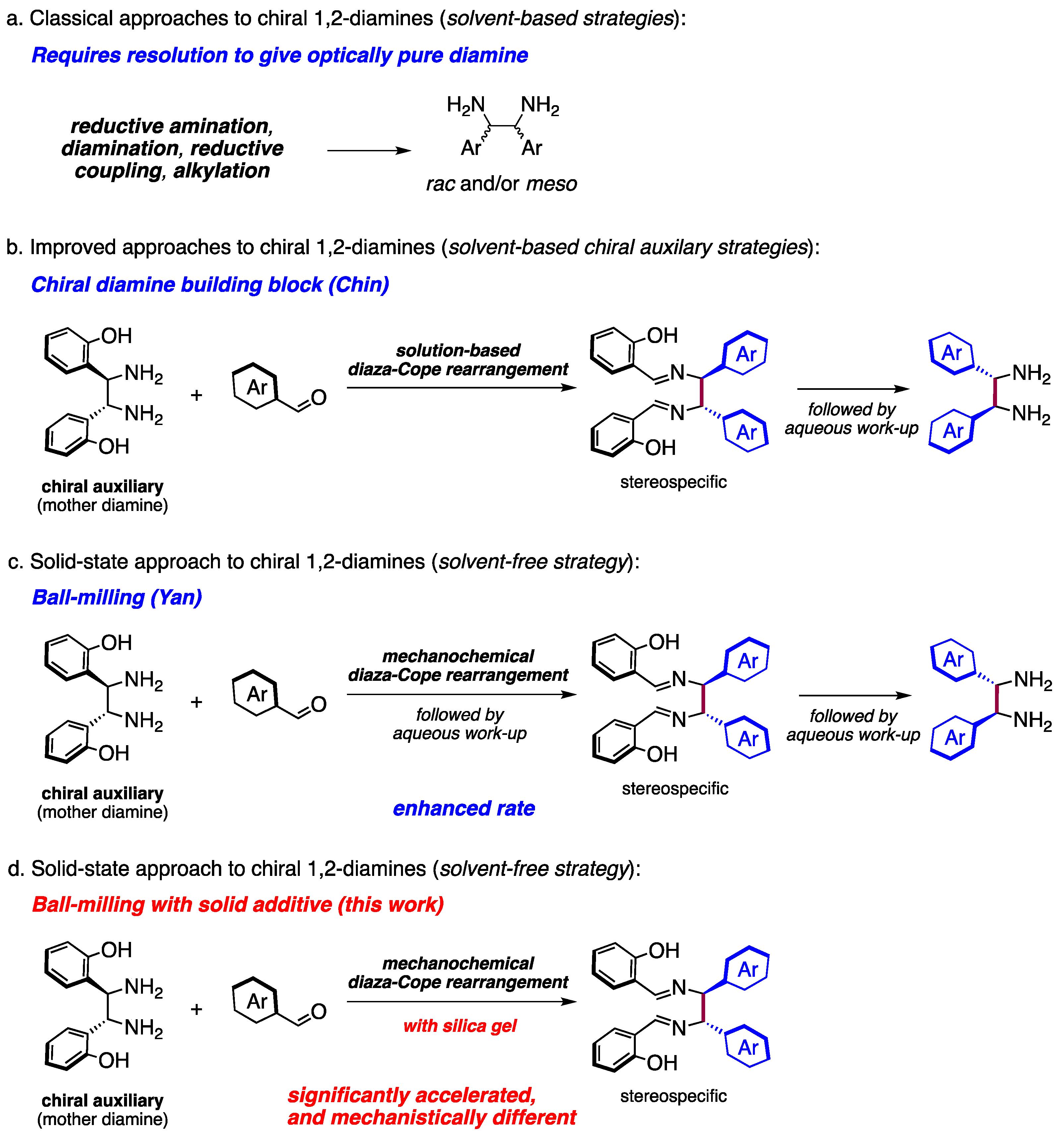
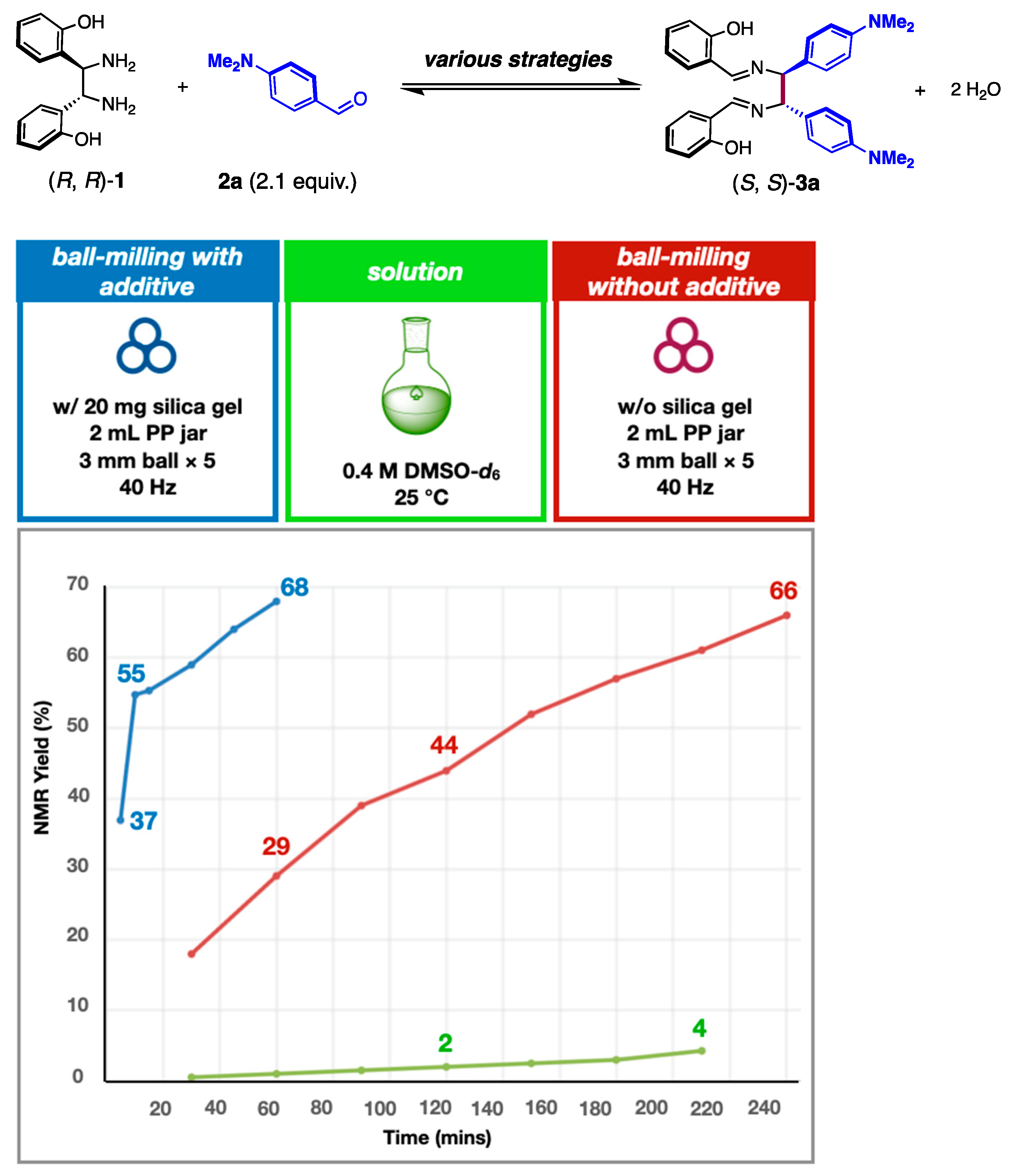
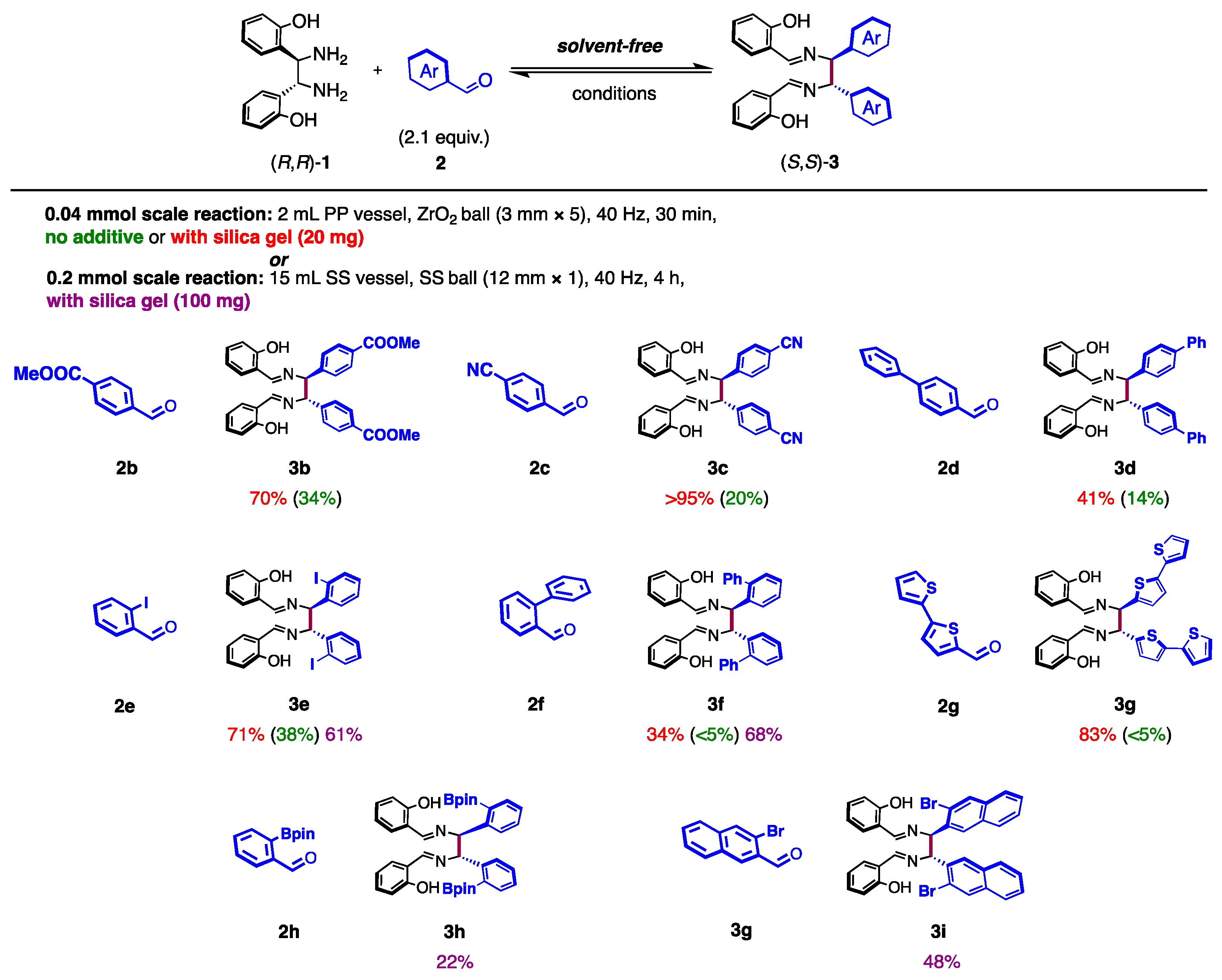
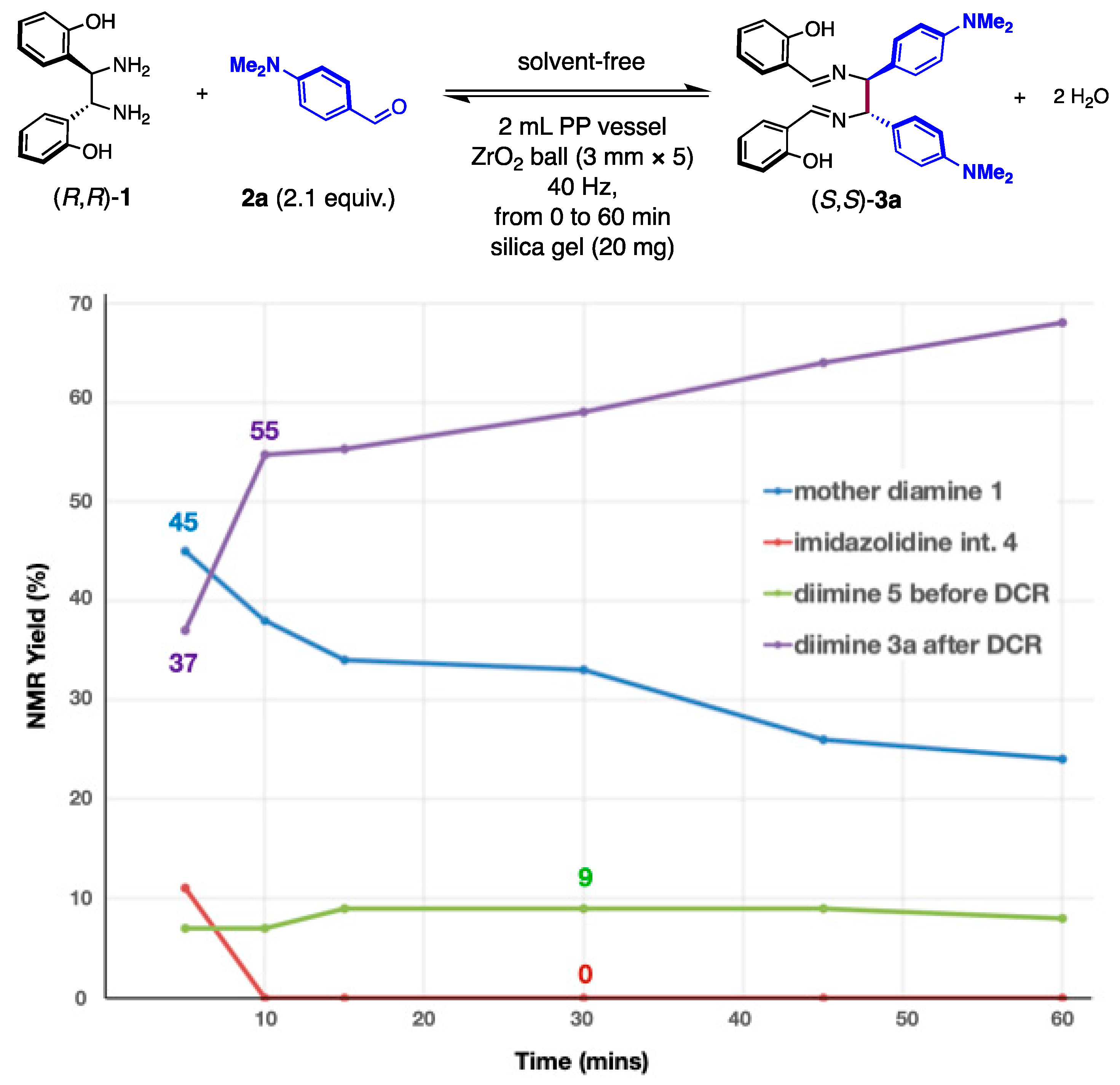
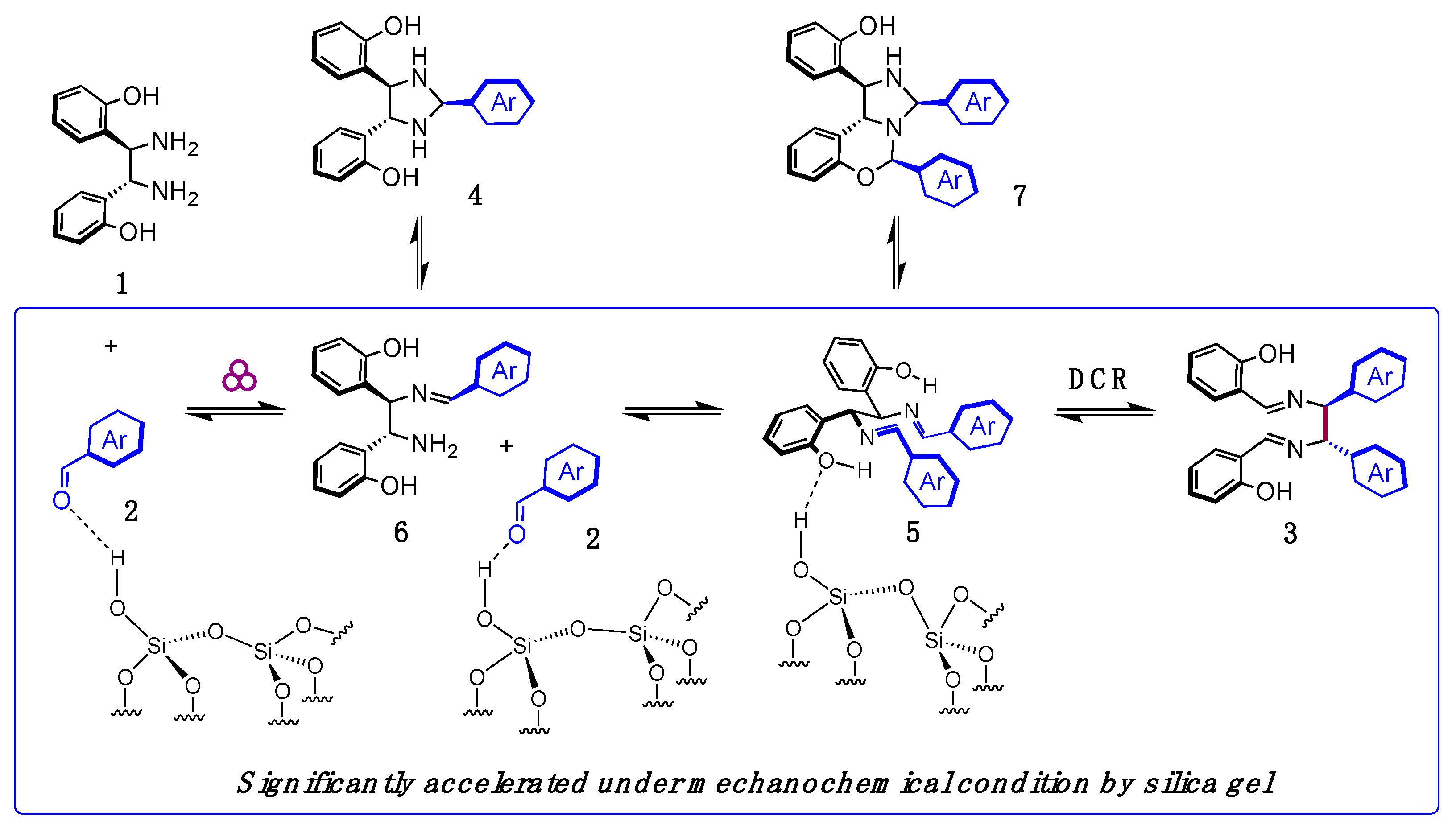

| Entry | Additive | NMR Yield (%) a |
|---|---|---|
| 1 | none | 18 |
| 2 | NaCl | <5 |
| 3 | NaHCO3 | <5 |
| 4 | Na2HPO4 | <5 |
| 5 | NaOAc | <5 |
| 6 | NaHCO3 | <5 |
| 7 | Na2CO3 | <5 |
| 8 | KOAc | <5 |
| 9 | K2CO3 | <5 |
| 10 | Cs2CO3 | <5 |
| 11 | ZnCO3 | <5 |
| 12 | p-TsOH | 0 |
| 13 | B(OH)3 | 0 |
| 14 | AlCl3 | <5 |
| 15 | CeO2 | <5 |
| 16 | La2O3 | <5 |
| 17 | ZrO2 | 9 |
| 18 | Al2O3 | <5 |
| 19 | silica gel b | 62 (38) c |
| 20 | silicon dioxide | 7 |
| 21 | Fe2O3 | 9 |

| Entry | Size of Silica Gel Particle | NMR Yield (%) a |
|---|---|---|
| 1 | 60–100 mesh | 52 |
| 2 | 100–200 mesh | 55 |
| 3 | 200–300 mesh | 50 |
| 4 | 300–400 mesh | 62 |
| 5 b | 300–400 mesh (314 °C) | 20 |
| 6 b | 300–400 mesh (528 °C) | 16 |

| Entry | LAG (µL/mg) | NMR Yield (%) a |
|---|---|---|
| 1 | EtOH (0.5) | <5 |
| 2 | EtOH (1.0) | <5 |
| 3 | EtOH (1.5) | <5 |
| 4 | EtOH (2.0) | <5 |
| 5 | DMSO (0.5) | 25 |
| 6 | DCM (0.5) | 54 |
| 7 | petroleum ether (0.5) | <5 |
Publisher’s Note: MDPI stays neutral with regard to jurisdictional claims in published maps and institutional affiliations. |
© 2022 by the authors. Licensee MDPI, Basel, Switzerland. This article is an open access article distributed under the terms and conditions of the Creative Commons Attribution (CC BY) license (https://creativecommons.org/licenses/by/4.0/).
Share and Cite
Cheng, T.; Ma, W.; Luo, H.; Ye, Y.; Yan, K. Manipulating Reaction Energy Coordinate Landscape of Mechanochemical Diaza-Cope Rearrangement. Molecules 2022, 27, 2570. https://doi.org/10.3390/molecules27082570
Cheng T, Ma W, Luo H, Ye Y, Yan K. Manipulating Reaction Energy Coordinate Landscape of Mechanochemical Diaza-Cope Rearrangement. Molecules. 2022; 27(8):2570. https://doi.org/10.3390/molecules27082570
Chicago/Turabian StyleCheng, Tingting, Wenxian Ma, Hao Luo, Yangzhi Ye, and KaKing Yan. 2022. "Manipulating Reaction Energy Coordinate Landscape of Mechanochemical Diaza-Cope Rearrangement" Molecules 27, no. 8: 2570. https://doi.org/10.3390/molecules27082570
APA StyleCheng, T., Ma, W., Luo, H., Ye, Y., & Yan, K. (2022). Manipulating Reaction Energy Coordinate Landscape of Mechanochemical Diaza-Cope Rearrangement. Molecules, 27(8), 2570. https://doi.org/10.3390/molecules27082570






